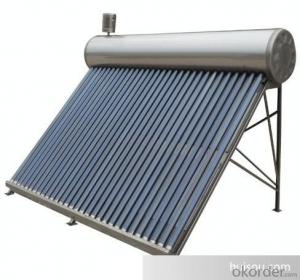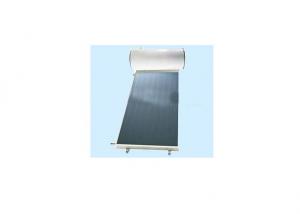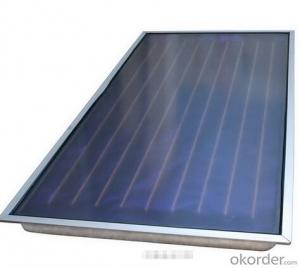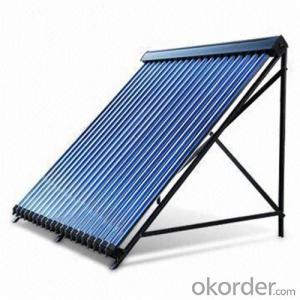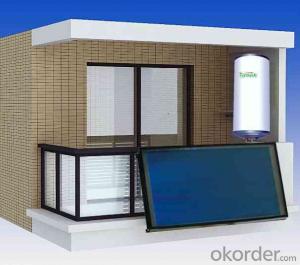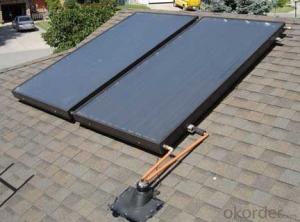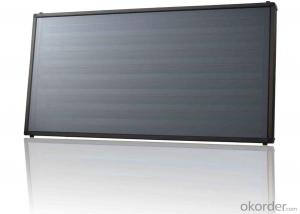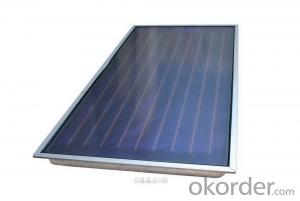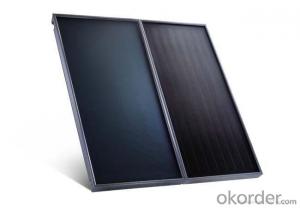Heat Pipe with Copper Solar Water Heater System 2015 New Design
- Loading Port:
- China main port
- Payment Terms:
- TT OR LC
- Min Order Qty:
- 1 set
- Supply Capability:
- 6000 set/month
OKorder Service Pledge
OKorder Financial Service
You Might Also Like
Introduction of Non-Pressure Solar Water Heater:
Non-pressure Solar Heater is one of the most economical solar water heating device with pretty high efficiency at the same time. It consists of hot water storage tank, solar vacuum tubes with mouth plug in storage tank, and bracket supporting tank and tubes.When cold water in evacuated tubes is heated with solar irradiation, as the specific gravities of hot water and cold water are different, hotter water goes upward to storage tank and colder water goes downward to glass tubes. through this continuous circulation, the cold water in storage tank will be gradually heated till sunset.
Specialty:
1. High thermal performance and working temperature: the heat exchanging rate even in winter can up above 55%.
2. Heat collecting efficiency is at least 20% above common solar systems.
3. Work in all day and all season: no matter any corner of the world, this system can work well even -40℃ to avoid the tube freezing problem.
4. Reliability: No water following through the tube, so water scale can not generate and tube cracks could be avoided, the system still can keep working even with some damaged tubes.
5. It can connect with water tap and work automatically with pressure0.6Mpa, bring enjoyable washing experience.
6. Safety: P/T valve would release pressure and temperature to protect tank..
Technical Specification:
1. Outer tank material: SUS304 stainless steel or powder coated color steel
2. Inner tank material: 1.2mm thick SUS304 food grade stainless steel ( Optional material SUS316L)
3. Vacuum tube material: borosilicate glass 3.3; AL-SS-CU absorb coating, with copper heat pipe inside
4. Frame material: 1.2mm thickness stainless steel
5. Insulation material: 55mm thickness polyurethane
6. Suitable for mains pressure water(up to 8 bar/116psi)
7. Easy plug-in installation
8. Install the T/P valve on the pressurized tank
9. Seal material: Stabilized High Temperature Silicon
Outer tank material: SUS304 stainless steel or powder coated color steel
Inner tank material: 1.2mm thick SUS304 food grade stainless steel ( Optional material SUS316L)
Vacuum tube material: borosilicate glass 3.3; AL-SS-CU absorb coating, with copper heat pipe inside
Frame material: 1.2mm thickness stainless steel
Insulation material: 55mm thickness polyurethane
Suitable for mains pressure water(up to 8 bar/116psi)
Easy plug-in installation
Install the T/P valve on the pressurized tank
Seal material: Stabilized High Temperature Silicon
19. Vacuum Tube | 20. Size (mm) | 21. Φ47*1500 / Φ58*1800 / Φ70*2100 | |||||
22. Tube (pcs) | 23. 10 / 12 / 15 / 18 / 20 / 22 / 24 / 30 / 36 / 42 | ||||||
24. Material | 25. Borosilicate 3.3 glass, magnetron spluttering selective coating | ||||||
26. Coating | 27. Single-target AL-N/AL or Three-target AL/N-Cu-SS | ||||||
28. Water Tank | 29. Capacity | 30. 80L ~ 500L for hot water storage tank | |||||
31. Inner tank | 32. Food-grade stainless steel SUS304-2B / SUS316 | ||||||
33. Insulation | 34. High-density polyurethane foam with 70~80 hour heat preservation | ||||||
35. Tank shell | 36. Food-grade stainless steel SUS304-2B | ||||||
37. Bracket | 38. Shaped strong aluminum alloy structure adaptable for flat or slope roof | ||||||
39. Accessories | 40. Anti-aging silicon seals, Dustproof seals, Air-vent cap, Stainless screws | ||||||
41. Auxiliary Devices | 42. Assistant tank, Intelligent controller, Electrical heater, Magnesium anodes | ||||||
43. Tilt Angle | 44. 25 ~ 50° | ||||||
45. Water Output | 46. 45 - 95°C | ||||||
47. Hail Resistance | 48. Φ25mm diameter | ||||||
49. Model Number | 50. Solar Vacuum Tube | 51. Tank 52. Liter | 53. System 54. Liter | 55. Container Loading Qty /sets | |||
56. Size /mm | 57. Qty /pcs | 58. 20GP | 59. 40GP | 60. 40HQ | |||
61. VNS-58SA12-100 | 62. Φ58*1800 | 63. 12 | 64. 100 | 65. 132 | 66. 58 | 67. 119 | 68. 140 |
69. VNS-58SA15-130 | 70. 15 | 71. 130 | 72. 170 | 73. 54 | 74. 108 | 75. 131 | |
76. VNS-58SA18-150 | 77. 18 | 78. 150 | 79. 198 | 80. 43 | 81. 86 | 82. 105 | |
83. VNS-58SA20-170 | 84. 20 | 85. 170 | 86. 223 | 87. 40 | 88. 80 | 89. 97 | |
VNS-58SA24-200 | 24 | 200 | 263 | 35 | 70 | 85 | |
VNS-58SA30-250 | 30 | 250 | 329 | 28 | 56 | 68 | |
VNS-58SA36-300 | 36 | 300 | 395 | 23 | 47 | 57 | |
Product Show
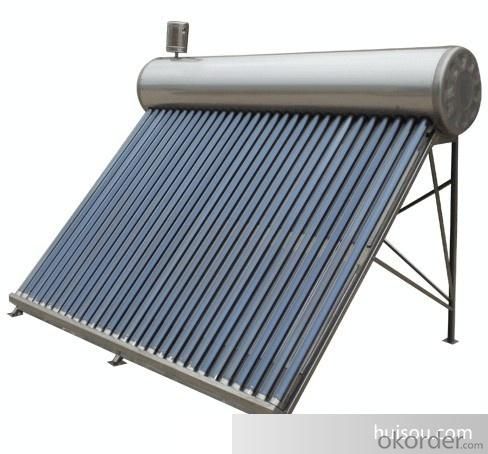
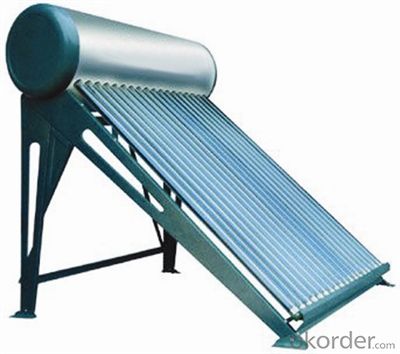
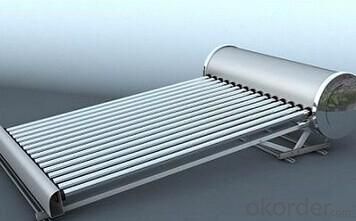
Our Services
1. OEM service
2. Warranty: 5 years
3. Considerable after sale service
Color steel Compact pressure Thermal solar heater
FAQ:
1. What’s the delivery time?
10 days after receiving deposit.
2. How long is the warranty?
5 years for whole system, 1 year for accessory
3. What’s your production capacity?
6000sets/month
4. What’s the MOQ?
1 set.
5. What’s your payment term?
Container: 30% T/T in advance for deposit, 70% T/T before shipment for fist order.
70% T/T after seeing copy of B/L from second order
Sample: 100% T/T in advance
Other choices: L/C at sight.
6. What certifications do you have?
CE, SOLAR KEYMARK, SRCC and etc.
- Q:Can solar collectors be installed on a flat roof?
- Yes, solar collectors can be installed on a flat roof. In fact, flat roofs are a popular choice for solar installations as they provide a large surface area for optimal sun exposure and can be easily accessed for maintenance and installation purposes.
- Q:What is the maintenance cost of a solar collector?
- The maintenance cost of a solar collector can vary depending on factors such as the size and type of the collector, as well as the specific location and climate. Generally, solar collectors require minimal maintenance. Routine tasks may include cleaning the collector surface, checking for any damage or leaks, and inspecting the components to ensure optimal performance. Additionally, periodic professional inspections and possible repairs might be needed, which would incur additional costs. Nonetheless, compared to other energy systems, the maintenance cost of a solar collector is typically low, resulting in long-term cost savings.
- Q:Can solar collectors be used for heating assisted living facilities?
- Yes, solar collectors can be used for heating assisted living facilities. Solar thermal systems can harness the sun's energy to heat water or air, which can be used for space heating and hot water supply in these facilities. This can help reduce energy costs and environmental impact while providing a reliable source of heating.
- Q:Can solar collectors be used for heating in areas with high humidity?
- Yes, solar collectors can be used for heating in areas with high humidity. While high humidity can affect the efficiency of solar collectors to some extent, it does not render them completely ineffective. Solar collectors work by capturing the sun's energy and converting it into heat, which can then be used for space heating or water heating. In areas with high humidity, the moisture in the air can reduce the amount of direct sunlight that reaches the solar collectors. This can result in a slightly lower efficiency compared to areas with lower humidity. However, even in high humidity environments, solar collectors can still generate enough heat to be used for heating purposes. Moreover, advancements in solar collector technology have led to the development of more efficient and effective systems that can better handle humid conditions. For example, some solar collectors use special coatings on their surfaces to minimize the impact of humidity on their performance. Additionally, the use of heat exchangers and insulation in solar heating systems can further enhance their efficiency in high humidity areas. It is important to note that while solar collectors can still be used for heating in areas with high humidity, it is essential to properly design and size the system to account for the unique environmental conditions. This may involve selecting the appropriate type of solar collector, optimizing its orientation and tilt, and considering factors such as shading and ventilation to maximize its performance. Overall, while high humidity can have a slight impact on the efficiency of solar collectors, they can still be effectively used for heating purposes in such areas with proper design considerations and technological advancements.
- Q:Can solar collectors be installed on any type of building?
- Yes, solar collectors can be installed on any type of building as long as the structure has adequate roof space or open land to accommodate the installation.
- Q:Can solar collectors be used for heating in coastal areas?
- Yes, solar collectors can definitely be used for heating in coastal areas. The proximity to the coast does not affect the functionality of solar collectors, as they primarily rely on sunlight to generate heat. Coastal areas often experience ample sunshine, making them suitable for solar heating systems. Additionally, the coastal climate can provide favorable conditions for efficient heat transfer and reduced energy consumption, making solar collectors a viable and sustainable option for heating in such areas.
- Q:Is it possible to store excess energy generated by solar collectors?
- Yes, it is possible to store excess energy generated by solar collectors. This can be done through the use of batteries or other energy storage systems, allowing the stored energy to be used during times when the solar collectors are not producing enough energy, such as at night or during cloudy weather.
- Q:How do solar collectors compare to traditional fossil fuel-based heating systems in terms of emissions?
- Solar collectors are significantly more environmentally friendly than traditional fossil fuel-based heating systems in terms of emissions. Fossil fuel-based heating systems release greenhouse gases and other pollutants into the atmosphere, contributing to climate change and air pollution. On the other hand, solar collectors harness the sun's energy, producing zero emissions during operation. This makes them a cleaner and more sustainable option for heating systems.
- Q:How do solar collectors affect property value?
- Solar collectors can have a positive impact on property value. Installing solar collectors on a property can increase its attractiveness to potential buyers, as it demonstrates the homeowner's commitment to sustainability and renewable energy. Solar collectors provide a source of clean and renewable energy, which can lead to reduced energy costs for the homeowner. This financial benefit can also be appealing to potential buyers, as it can result in long-term savings on utility bills. Additionally, solar collectors may also qualify for various government incentives and tax credits, which can further enhance the property's value. Overall, the presence of solar collectors on a property can enhance its desirability and marketability, potentially increasing its value.
- Q:What is the maintenance cost for solar collectors?
- The maintenance cost for solar collectors can vary depending on the type and size of the system, as well as the specific components used. Generally, the maintenance cost for solar collectors is relatively low compared to other forms of energy generation. One of the main maintenance tasks for solar collectors is cleaning the panels to ensure optimal efficiency. This can be done using water and a soft cloth or sponge. In some cases, if the panels are installed at an angle, rainwater may be sufficient to keep them clean. Regular inspection of the system is also important to identify any issues or damage that may require repairs. This includes checking for loose connections, damaged wiring, or any signs of wear and tear. It is recommended to have a professional technician perform these inspections to ensure safety and proper functioning of the system. In terms of costs, routine maintenance for solar collectors typically involves minimal expenses. Cleaning supplies, such as water and cleaning agents, may be required, but these are generally low-cost items. If any repairs or replacements are needed, such as fixing a broken panel or replacing a faulty component, the cost will depend on the specific issue and the extent of the repair. Overall, while there are some maintenance tasks and potential costs associated with solar collectors, they are generally minimal compared to the long-term benefits and savings provided by solar energy.
1. Manufacturer Overview |
|
|---|---|
| Location | |
| Year Established | |
| Annual Output Value | |
| Main Markets | |
| Company Certifications | |
2. Manufacturer Certificates |
|
|---|---|
| a) Certification Name | |
| Range | |
| Reference | |
| Validity Period | |
3. Manufacturer Capability |
|
|---|---|
| a)Trade Capacity | |
| Nearest Port | |
| Export Percentage | |
| No.of Employees in Trade Department | |
| Language Spoken: | |
| b)Factory Information | |
| Factory Size: | |
| No. of Production Lines | |
| Contract Manufacturing | |
| Product Price Range | |
Send your message to us
Heat Pipe with Copper Solar Water Heater System 2015 New Design
- Loading Port:
- China main port
- Payment Terms:
- TT OR LC
- Min Order Qty:
- 1 set
- Supply Capability:
- 6000 set/month
OKorder Service Pledge
OKorder Financial Service
Similar products
New products
Hot products
Hot Searches
Related keywords
